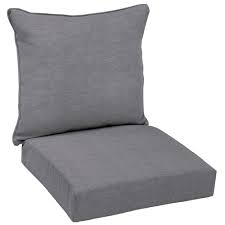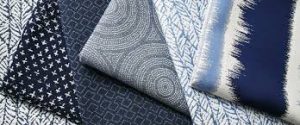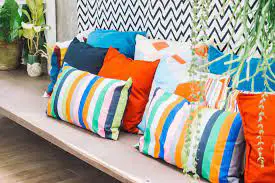Outdoor cushions aren’t just to make your backyard patio furniture look beautiful and comfortable to sit on. They help make your homeownership experience easier by eliminating the task of taking in the paddings whenever it’s raining or snowing outside.
Multiple companies have produced outdoor cushions for you to choose from, depending on your cover design and padding build preference. But two top brands fight for the best outdoor cushion fabric among homeowners: Sunbrella vs CushionGuard.
So, CushionGuard vs Sunbrella. What’s the Best Material for Outdoor Cushions? There is no definitive answer as it all boils down to the style and needs of your outdoor furniture as well as your budget and time for maintenance. In this article, we’ll discuss the differences between CushionGuard and Sunbrella outdoor fabrics and their selling points and cons.
To start, let’s talk about what each fabric brand is made of so you can choose the best outdoor fabric for your outdoor furniture.
Table of Contents
What are CushionGuard Outdoor Fabrics?
Understanding CushionGuard requires us first to ask the question, What is CushionGuard fabric made of? This outdoor fabric is a Home Depot exclusive made of solution-dyed polyester. It’s common knowledge that polyester fabric is popular in sportswear for its durability, strength, and inability to absorb water. But in CushionGuard’s case, the water-resisting properties are multiplied due to the increased thread count per square inch.
In addition to that, the polyester of CushionGuard’s making is dyed for long-lasting color life and increased water resistance. If you spill a glass of water into CushionGuard’s outdoor fabric, the water will not seep through, keeping the foam dry inside.

Sounds too good to be true, doesn’t it? You might be wondering if there are any drawbacks of CushionGuard. Their outdoor fabrics cannot repel water under constant heavy rain. CushionGuard fabrics only have a warranty of three years. And third, CushionGuard’s UV-resistant level isn’t that high, which means that the colors may fade sooner than other leading brands.
It would be too unfair only to discuss the bad sides of Home Depot’s product. So here are CushionGuard’s selling points. Let’s start with the price. When it comes to outdoor fabrics, homeowners are always surprised to see the price tags when shopping. But CushionGuard stays in the price range of $50-$100 per square yard, and that’s lower than other competitors on the market.
In terms of comfort and maintenance, patio furniture owners give the brand the highest score due to their fabric’s smooth and softer texture that is easy to clean. Polyester is also tougher against tearing in both intentional force and weather exposure.
What are Sunbrella Outdoor Fabrics?
Like CushionGuard, we’ll start with the question, What is Sunbrella made of? But unlike the former brand, Sunbrella has its products made from solution-dyed acrylic. Polyester and acrylic are synthetic materials made out of petroleum.

The differences are that acrylic retains more heat than polyester. It pills easily after frequent friction. It is weak against punctures and tearing caused by sharp objects. It develops static electricity from friction and direct sun exposure. It dissolves in acetone. It is scratchier and hard to touch. It is less soft. It almost lacks breathability. And it is more expensive.
Moving on to the benefits. Sunbrella, as an outdoor fabric, is more stain, rain, snow, and mildew resistant than CushionGuard. Its color has longer life due to the acrylic having more UV inhibitors and can be washed with bleach without worries of fading. And when it comes to design, Sunbrella outdoor fabrics have more color palettes and patterns to choose from. They are all designed with high-end outdoor and indoor furniture aesthetics in mind.
Cushionguard vs Sunbrella. What’s the best material for outdoor cushions? Side by Side Comparison.
Durability
Sunbrella’s solution-dyed acrylic fabrics are more durable against the weather. In contrast, CushionGuard’s solution-dyed polyester fabrics come in second. This result isn’t just based on customer experience but is also proven by science. There is one thing that CushionGuard does better than Sunbrella as an outdoor fabric; it’s tougher against pointed objects and fallen debris.
So which lasts longer? CushionGuard or Sunbrella? Sunbrella is the superior outdoor fabric when it comes to longevity-based durability. Each thread of Sunbrella outdoor fabrics is yard-dyed, making each product’s colors and patterns last longer even when left outside to brave the elements. And they don’t easily rip or tear when sat on after years of being subjected to extreme weather (heavy rain, snow, and summer sun).
Check out the sunbrella durability challenge video below.
Functionality
When sat on after exposure to direct sunlight, the outdoor fabrics from CushionGuard stay relatively cool. In contrast, Sunbrella-covered cushions tend to make you jolt back up after sitting because of the retained heat from sun exposure. Not only that, but Sunbrella’s solution-dyed acrylic isn’t very breathable.
It can take minutes for the cushions to deflate and take form according to your butt and back’s shape for comfort. In addition to these points, customers report that almost all of Sunbrella’s exterior textures are scratchy and can zap you upon contact with its built-up static electricity from sun exposure.
From this observation alone, we can surmise that CushionGuard reigns as the better outdoor fabric on the issue of functionality. Your behind and back won’t get burned or zapped after sitting on a CushionGuard-covered foam under direct sunlight. Suppose you’re looking to sunbathe in your backyard on your chaise lounge chair, and you’ve chosen CushionGuard fabrics. In that case, you can spend minutes to hours without feeling any roughness on your bare skin.
Water Resistance
Multiple reviews have shown that the interior foam covered by Sunbrella outdoor fabrics does stay dry when left outside during moderate to heavy rainfall and snow. This is due to the tighter weaving, more thread count per square inch than CushionGuard, thicker dyeing process, and acrylic are better hydrophobic characteristics. Your pants won’t get wet when sitting on a Sunbrella-covered cushion after a rain or when the snow has melted.
On the other hand, CushionGuard fabric for outdoor furniture only fares well against light to moderate rainfall. When left longer under heavy rain, the foam will get soaked, leading to mold growth and a bad odor.
Sitting on a foam covered by CushionGuard fabrics after a downpour is more likely to soak your pants. If you’re lucky, the water will fall into the bottom of the outdoor furniture when the foam is squeezed and not drench your bottom garments. Lastly, CushionGuard has minimal and very few reviews online. These factors cause widespread skepticism among homeowners when investing in Home Depot’s outdoor fabric brand.
Which is the best outdoor fabric in terms of being water-resistant? We’re giving the title of completely waterproof to Sunbrella here.
Cost
Solution-dyed acrylic is more expensive than solution-dyed polyester fabric, and both materials come from petroleum. But acrylic undergoes more processes to become what it is than polyester. It’s also mentioned that high-end designers create the colors and patterns of Sunbrella fabrics.
Sunbrella products don’t go below the $100 marker, whereas CushionGuard’s merchandise stays in the $50-$100 price range. Another thing, Sunbrella fabrics are highly in demand. They are the best brand due to their higher quality and popularity. And if there’s one thing we know about economics, high-demand products tend to be more expensive.
So which is more expensive? Sunbrella fabrics or CushionGuard? The paragraph above clearly states that Sunbrella is far pricier than its Home Depot competition. CushionGuard is the best outdoor fabric to choose from if you want to save money.
Eco-Friendliness
Neither Sunbrella nor CushionGuard is an environmentally friendly outdoor fabric brand. Polyester and acrylic fabrics are both plastics and made from petroleum – a byproduct of crude oil and natural gasses which are types of fossil fuels. Their colors and patterns fade, and their fabric structure will break down in time, but the plastic particles won’t degrade or decompose.
Maintenance and Care
Both CushionGuard and Sunbrella are easy to maintain and care for. Spill any food, beverage, or even mud on these fabrics, and you can easily wipe them off with a sponge, piece of cloth, or mild soap and water. You won’t have to worry about stains caused by a drunk friend spilling their wine on your outdoor furniture or a kid using your cushions as their painting canvass.
Acrylic and polyester are two types of synthetic fabric that cannot absorb stains. Simply speaking, both fabric brands are stain-resistant. Don’t believe us? Watch these videos of CushionGuard and Sunbrella outdoor fabric liquid spill tests.
There are two significant differences here that give Sunbrella outdoor fabric the edge in care and maintenance. One is that you can leave the outdoor fabric in heavy rain. Two, you can wash Sunbrella fabrics with bleach in case of severe stains from excrement, blood, hot cocoa, and permanent markers.
Fade Resistance
Ultraviolet rays break down the chemical bonds, leading to the fading of colors in objects and outdoor fabrics. However, solution-dyed acrylic has far better UV-resistant properties than solution-dyed polyester. This gives the color of an outdoor cushion covered by Sunbrella outdoor fabric a longer life even when constantly exposed to UV rays.
Mold and Mildew Resistance
Polyester and acrylic fibers are made from plastic, and plastics are mold and mildew-resistant. The only difference is that a CushionGuard fabric is likely to experience these fungal growths internally due to the high probability of water seeping through the threads under snow and heavy rain.
Money-saving tip: You can avoid mold growth if you airdry the CushionGuard-covered foam after being wet. Don’t dry it under the sun if you want to preserve the colors and patterns. So which is the better mold-resistant fabric brand for your outdoor furniture? That would be Sunbrella.
Availability – Ease of Access
So far, Sunbrella has scored 5 out of 9 in this comparison segment, and we’ll add the sixth point due to the products of the fabric brand being sold in multiple stores. Why nine only? It’s because both fabric brands failed the eco-friendliness test.
If only Home Depot allowed their quick-drying fabrics to be sold on Amazon and other eCommerce sites, rather than making them store-exclusive, they would tie with Sunbrella in terms of availability.
Know where to buy Sunbrella fabrics or premade upholstery by visiting their official website, Wayfair, BALLARD DESIGNS, POTTERY BARN, and Crate&Barrel. It’s also worth mentioning that Sunbrella is available globally. Check this link out and find the closest Sunbrella selling shop from your location.
Products
Sunbrella has more product variety in terms of outdoor fabric color and design for pillows and upholsteries to fit your outdoor furniture setup preference. If you’re also looking for indoor fabrics, they have hundreds of designs! And counting all the colors and patterns available on Subrella fabrics would take too much time.
On the other hand, CushionGuard doesn’t have many patterns and colors for its outdoor fabrics. We can estimate that there are only less than 150 designs available. They tend to manufacture monocolored materials for outdoor furniture.
Sunbrella vs CushionGuard: Which is Better Overall?
Scoring 7 out of 9 in durability, product variation, availability, maintenance and care, fade, water, mildew, and mold resistance, we’re giving the title of the “best outdoor fabric” in this article to Sunbrella. Home Depot’s CushionGuard only has two points for the best functionality and price. But that doesn’t mean CushionGuard shouldn’t be considered.
You can still choose to buy Home Depot’s product if you want to save money and have the time to store your outdoor cushions inside whenever the weather is about to get worse. We even recommend CushionGuard to households that have domestic maids — provided that they instruct the maids to bring the cushions in before it rains or snows.
FAQs – Differences between Sunbrella and CushionGuard
What cushions are comparable to Sunbrella?
According to customers, cushions covered by Outdura fabrics are equally matched in performance with Sunbrella in terms of fade, mildew, mold, weather resistance, water repellency, and durability. Both Sunbrella and Outdura are made of solution-dyed acrylics. But Sunbrella has the advantage of having more designs, and Outdura is the cheaper option.
Is CushionGuard fabric waterproof?
Not all outdoor fabrics are made the same. CushionGuard may be a high-quality fabric, but it will eventually get wet inside when left outdoors for long periods, especially in heavy rain.
Is CushionGuard fade-resistant?
Yes. CushionGuard is fade resistant to a degree. An important factor to remember is that CushionGuard is solution-dyed polyester, and it doesn’t fade easily when washed regularly. Still, it will lose its coloring and many patterns if frequently exposed to direct sunlight.
We recommend matching your CushionGuard-covered outdoor furniture set with a canopy. And if you want to get the best of both brands, cover your patio with a Sunbrella shade sail.
Is Sunbrella fabric really worth it?
Money-wise, Sunbrella isn’t the best fabric to cover your outdoor furniture foams. You can choose the cheaper and equally-reliable Outdura. When it comes to overall comfort, Sunbrella is scratchy to our skin.
The synthetic fibers don’t stay cool under the sun. It also lacks breathability, causing your initial seating experience to be hard. But suppose you don’t mind splurging on a company that offers more outdoor fabric designs than the others. In that case, Sunbrella is worth spending on.
Are there different grades of Sunbrella?
There are three different grades of Sunbrella fabrics: Seamark, Supreme, and Rain. Seamark’s outer side is solution-dyed acrylic, while the inner surface is vinyl. It’s completely waterproof but has sacrificed breathability.
Supreme is the same as Seamark, with the difference of having a linen flock underside. Unlike Seamark, Supreme is “essentially waterproof” and resistant against scratches. Sunbrella Rain is a new and the most expensive waterproof line that underwent a specialized manufacturing process during the coating phase.
Like Seamark, it also lacks breathability and isn’t available to retail customers.
Conclusion
Both Sunbrella and CushionGuard are great outdoor fabric brands. The first wins in durability and design versatility, while the other triumphs in comfort and price. CushionGuard is a great outdoor fabric choice for your outdoor furniture and wallet if you don’t mind putting away the cushions when it’s about to snow or rain heavily outside. It’s also the best pick for you, your family, and your guests’ comfort.
However, suppose money is not an issue for you, and you don’t have the time to take the cushions inside your home when the weather is about to worsen. In that case, Sunbrella is the right outdoor fabric for your premium outdoor furniture. These two brands are created equally to provide a quality outdoor experience for anyone who wishes to relax outside their homes during summer and spring. And both deliver their purposes well.

